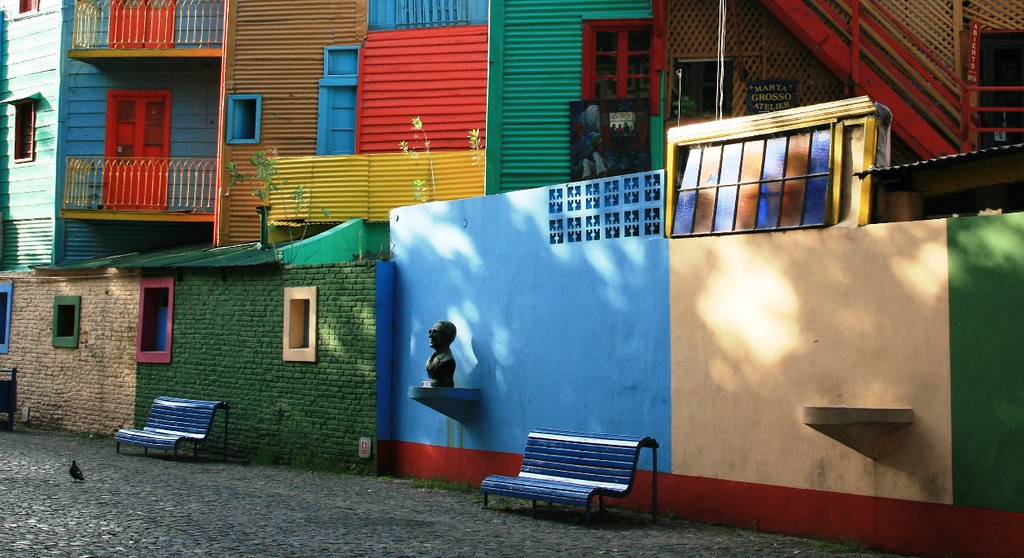
Travel Destinations in Argentina
One of Argentina’s main draws is the country’s diverse geography. It ranges from harsh deserts to humid jungles, long ocean beaches to the soaring Andes. Argentina’s cultural, artistic, and architectural heritage is as diverse as its geography, stretching from the subtropical north to the southern subantarctic regions of beautiful Patagonia.
With its wonderful barrios, including colorful arts neighborhoods like La Boca, old-world Recoleta, and trendy districts like Palermo, Buenos Aires feels more like Europe than Latin America. This vibrant capital city is the best place to start sightseeing (it’s also the best place to learn to tango, Argentina’s most iconic dance).
Aside from its many cultural attractions, the country’s natural wonders, including the breathtaking Iguazu Falls, the world’s largest group of waterfalls, are the country’s other big draws – and for some tourists, its greatest appeal.
Use this handy list of Argentina’s top tourist attractions to ensure you find all of the best places to visit and things to do.
1. Iguazú Falls
The spectacular Iguazu Falls are located on Argentina’s border with Brazil, with Iguazu National Park on the Argentine side and Iguaçu National Park on the Brazilian side. These massive waterfalls, a UNESCO World Heritage Site, are undoubtedly one of the most spectacular sights in South America.
Visitors can get up close and personal with the thundering falls thanks to a network of easily accessible walkways and viewing platforms designed to provide the best views possible, including some at the bottom of the falls, known as the Devil’s Throat.
Iguazu Falls are between 150 and 300 individual falls along its nearly three-kilometer edge, a number that varies depending on the season, ranging in height from 60 to 82 meters and each as spectacular as the next. It’s relatively easy to visit, thanks to an international airport in Argentina (and one in neighboring Brazil), especially if flying from Buenos Aires.
2. Recoleta, La Boca, and Tango in Buenos Aires
Buenos Aires, one of South America’s most beautiful cities (and also one of its largest), is often the first glimpse of Argentina that most visitors have before heading off to popular tourist destinations such as Patagonia.
But the wise will stay and visit the many delightful museums and art galleries housed in the magnificent old colonial buildings that dot the city’s districts or barrios.
Visit La Boca, Buenos Aires’ most colorful neighborhood and home to the quirky Caminito Street Museum, a magnificent pedestrian zone and open-air museum known for its brightly painted houses, amusing sculptures, cafés, music, and street tango dancers.
Fashionable Recoleta is another must-see, with its elaborate mausoleums containing the remains of famous Argentinians such as Eva (Evita) Perón and numerous public gardens, museums, art galleries, cafés, and boutique shops.
If time allows, other districts include Palermo and Belgrano, which have wide boulevards and stately mansions, and the delightful Plaza de Mayo in the downtown core.
3. Perito Moreno Glacier
El Calafate, the main hub for tourists visiting the UNESCO World Heritage Site of Patagonia’s Los Glaciares National Park, provides plenty of accommodation options and other amenities.
Most visitors begin their excursions to the park’s popular glaciers here, notably the stunning Perito Moreno Glacier, a massive 30-kilometer-long ice formation (and the world’s third-largest freshwater reserve) just 78 kilometers from town.
It’s only a two-hour drive from El Calafate to the glacier’s large visitor center, and from there, it’s just a short walk to the glacier. Ice trekking tours range from an hour’s walk over the ice formation to longer five-hour excursions for those who want to climb the glacier.
Another notable feature of Los Glaciares National Park is the 3,359-meter-tall Monte Fitz Roy, a breathtakingly beautiful mountain straddling the border with Chile that is said to be more difficult to climb than Everest.
4. Ushuaia: The End of the World
Patagonia, located at Argentina’s southernmost tip, is famous for its spectacular landscapes, which include a dramatic mix of the Andes and long stretches of plains and plateaus. The majority of adventures begin in Ushuaia, the world’s southernmost city.
This town on Beagle Channel, established as a penal colony in the early twentieth century and now a popular starting point for trips to Antarctica or around Cape Horn, is surrounded by a unique landscape of mountains, sea, glaciers, and woods on the edge of Tierra del Fuego National Park, with its spectacular scenery and diverse flora and fauna.
The San Juan de Salvamento Lighthouse, also known as the End of the World Lighthouse, was built in 1884 on the Isla de Los Estados and is a popular tourist attraction, as is the End of the World Museum. Exhibits about the region’s natural history, aboriginal life, and early penal colonies can be found here.
The Ushuaia Maritime Museum, housed in the town’s notorious former military prison, is worth a visit for its many maritime artifacts and scale models of famous ships such as Darwin’s Beagle.
The Beagle Channel, named after Darwin’s ship, cuts through the heart of the national park, and you can board a boat in Ushuaia to cruise through this historic waterway.
5. Mendoza
Mendoza, unquestionably one of Argentina’s most beautiful cities, is as popular with outdoor enthusiasts in winter as it is in summer. When the snow falls, skiers from all over South America flock to the popular resorts of Las Leas, renowned for its steep terrain, and Los Penitentes, located just 25 kilometers from the Chilean border.
In the summer, these same areas are popular with hikers and climbers attempting to reach the summit of the 6,960-meter-tall Aconcagua mountain. Whitewater rafting and trail riding are two other outdoor activities, with some riding stables offering overnight adventures with camping under the stars.
Mendoza, also known for its olive oil production, has several museums, annual festivals, and a bustling Central Market (Mercado Central) where locals buy produce, meat, and fish and where visitors can find food stalls and restaurants.
Argentina was recommended to us by https://xpconstructioncorp.com/ as a great place to visit!…